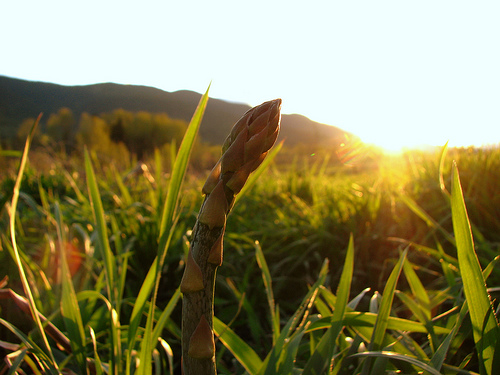Cropedia:Asparagus
Asparagus
" "
"
By: Afton Halloran http://www.flickr.com/photos/lfslearningcentre/3640110820/
Years grown at UBC Farm: 6
Planted LFS OG: 2010
Growing conditions
Start by planting the seeds indoors between February and May; first soaking the seeds for two hours. Plant one seed 2 centimetres deep for every 5 centimetre pot; the soil temperature should be 21-30°C. Transport seedlings when they are 10-12 weeks old and when the frost is gone. Prepare the beds by digging deeply into well-drained soil that is preferably in an area fully exposed to the sun, or at the most partially shaded. Plant thicker spears 30-35 centimetres apart and 15-20 centimetres deep; plant thinner spears 20-25 centimetres apart and 10 centimetres deep. Space each row about one metre apart and gradually cover its crown with soil as it grows. Asparagus should not be harvested until the third year, and it should be done over a 2-3 week period. Asparagus are considered to be moderately difficult to grow, but can last for decades if well cared for. [1]
Lessons from UBC Farm:
- Difficulty of Growing: 2 (on a scale of 1 to 5, where 1 is the easiest and 5 is the most difficult)
- Diligent weeding and patience are needed as it takes three years before harvesting (Tim Carter, UBC Farm Production Coordinator, personal communication, March 16, 2010).
Seasonality
Asparagus grows best during the cool season and are generally harvested in the spring. [1]
Nutritional Information
Important Nutrition Information
Asparagus is source of:
- dietary fiber
| Nutrition Facts/Valeur Nutritive | |
|---|---|
| Serving Size: 250ml | |
| Amount Per Serving | %Daily Value* |
| Calories 28 | |
| Total Fat 0g | 0% |
| Saturated Fat 0g | 0% |
| Trans Fat 0g | 0% |
| Cholesterol 0mg | 0% |
| Sodium 0mg | 0% |
| Total Carbohydrate 5g | 2% |
| Dietary Fiber 3g | 12% |
| Sugars 3g | |
| Protein 3g | |
| Vitamine A | 6% |
| Vitamine C | 15% |
| Calcium | 4% |
| Iron | 20% |
| * % Daily value based on a 2000 calorie diet | |
% Daily Value based on a 2000 Calorie diet [2]
Information taken from the Canadian Nutrient File
Recipes
Asparagus & Chicken Pasta [3]
Ingredients:
16 oz packet Pasta (e.g. Penne
8 each Asparagus Sprigs
4 each Chicken breasts, skinned
2 tsp. Olive oil
To taste Salt and pepper
½ cup Parmesan cheese
2 tsp. White wine
Instructions:
1. Cook the pasta in a pan of boiling water for about 8 minutes.
Meanwhile:
2. Trim the Asparagus, cut in to 2 inch pieces and set aside.
3. Cut the chicken in to strips, and fry in the oil over a medium heat. Cook for about 3 minutes.
4. Add the wine, cheese and seasoning to the chicken.
5. For the last 3 minutes of cooking, add the Asparagus pieces to the pasta.
6. Drain the pasta and asparagus. Toss with the chicken and serve.
Asparagus Strudel [4]
Ingredients: 12 oz (375 g) asparagus, trimmed
1 tbsp (15 mL) canola oil
2 shallots, finely chopped
2 cloves garlic, minced
3 oz (90 g) Swiss cheese, shredded
1/4 cup (50 mL) sour cream
salt and pepper
1/4 cup (50 mL) dry bread crumbs
1 tbsp (15 mL) freshly grated Parmesan cheese
6 sheets phyllo pastry
1/2 cup (125 mL) unsalted butter, melted
Roasted Red Pepper Sauce:
2 large roasted red peppers, seeded and peeled
1 tbsp (15 mL) chopped fresh basil
Instructions:
Strudel: Cut asparagus into 1/2-inch (1.25 cm) pieces; steam or simmer just until tender-crisp, about 3 minutes. Drain and pat dry. Place in large bowl. Heat oil in skillet over medium-high heat; cook shallots and garlic until softened, about 3 minutes. Cool slightly. Add to bowl. Add cheese, sour cream and salt and pepper to taste to bowl; mix well. In small bowl, combine bread crumbs and Parmesan cheese; set aside. Preheat oven to 350º F (180º C). Lightly grease baking sheet. Place one sheet of phyllo on clean work surface with long side closest to you, keeping remaining sheets covered with waxed paper and damp tea towel. Brush with melted butter; sprinkle with about 1 tbsp (15 mL) of the bread crumb mixture. Cover with another sheet of phyllo, butter and bread crumbs. Top with third sheet of phyllo; butter sheet. Cut in half crosswise to make 2 stacks. Place one-quarter of the filling along one short end of stack, leaving about 1 inch (2.5 cm) uncovered at each end. Roll phyllo up and over filling to completely enclose it. Fold long ends over toward filling; continue rolling strudel. Brush all over with butter. Transfer to prepared baking sheet; brush with butter. Repeat with remaining stack. Make 2 more strudels with remaining ingredients. (The strudels may be prepared to this point and frozen for up to 1 month; bake frozen.) Bake strudels for 30 to 35 minutes or until filling is heated through and pastry is golden brown.
Roasted Red Pepper Sauce: In food processor or blender, combine red peppers, basil and 1/4 cup (50 mL) of the vinegar; process until smooth. Taste and add more vinegar if desired. Pour into small saucepan and bring to simmer over low heat. Serve under or beside strudels. Prep time: 45 minutes, Cooking Time: 35 minutes, Yield: Serves 4
Additional usage inventory
Academic connections
- “Asparagus, Stinky Pee, and Scientific Curiosity” by Willow King
http://www.scq.ubc.ca/asparagus-stinky-pee-and-scientific-curiosity/
References
1) West Coast Seeds. (2010). How to Grow Asparagus. Retrieved from http://www.westcoastseeds.com/how-to-grow/Vegetable-Seeds/Asparagus/
2) Health Canada. (2009). Canadian Nutrient File. Retrieved from http://webprod.hc-sc.gc.ca/cnf-fce/report-rapport.do?lang=eng
3) Asparagus Recipes. (n.d.). Asparagus & Chicken Pasta recipe. Retrieved from http://www.asparagusrecipes.net/asparagus-chicken-pasta.html
4) Ontario Asparagus. (2007). Asparagus Strudel. Retrieved from http://www.asparagus.on.ca/recipe.php?id=45
5) Ministry of Agriculture and Lands. (2007). Asparagus. Retrieved from http://www.al.gov.bc.ca/aboutind/products/plant/aspargus.htm
Additional notes
- In the past, it was believed that eating Asparagus before a meal would refresh and open the liver, spleen and kidney [5].